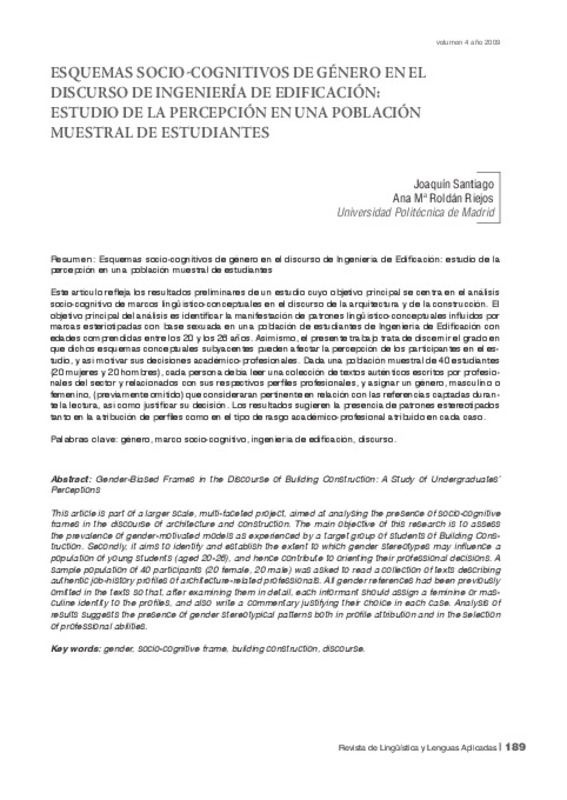JavaScript is disabled for your browser. Some features of this site may not work without it.
Buscar en RiuNet
Listar
Mi cuenta
Estadísticas
Ayuda RiuNet
Admin. UPV
ESQUEMAS SOCIO-COGNITIVOS DE GÉNERO EN EL DISCURSO DE INGENIERÍA DE EDIFICACIÓN: ESTUDIO DE LA PERCEPCIÓN EN UNA POBLACIÓN MUESTRAL DE ESTUDIANTES
Mostrar el registro sencillo del ítem
Ficheros en el ítem
| dc.contributor.author | Santiago, Joaquín
|
|
| dc.contributor.author | Roldán Riejos, Ana Mª
|
|
| dc.date.accessioned | 2011-04-01T12:47:15Z | |
| dc.date.available | 2011-04-01T12:47:15Z | |
| dc.date.issued | 2009 | |
| dc.identifier.issn | 1886-2438 | |
| dc.identifier.uri | http://hdl.handle.net/10251/10651 | |
| dc.description.abstract | [EN] This article is part of a larger scale, multi-faceted project, aimed at analysing the presence of socio-cognitive frames in the discourse of architecture and construction. The main objective of this research is to assess the prevalence of gender-motivated models as experienced by a target group of students of Building Cosntructio. Secondly, it aims to identify and establish the extent to which gender stereotypes may influene a population of young students (aged 20-26), an hance contribute to orienting theri professional decisions. A sample population of 40 participants (20 female, 20 male) wass asked to read a collection of texts desceibing authentic job-history profiles of architecture-related professionals.All gender references had been previously omitted in the texts so that, after examining them in detail, each informant should assign a feminine or masculine identity to the profiles, and also write a commentary justifying their choice in each case. Analysis of results suggests the presence of gender stereotypical patterns both in profile attribution and in the selection of professional abilities. | es_ES |
| dc.description.abstract | [ES] Este artículo refleja los resultados preliminares de un estudio cuyo objetivo principal se centra en el análisis socio-cognitivo de marcos lingüístico-conceptuales en el discurso de la arquitectura y de la construcción. El objetivo principal del análisis es identificar la manifestación de patrones lingüístico-conceptuales influidos por marcas esteriotipadas con base sexuada en una población de estudiantes de Ingeniería de Edificación con edades comprendidas entre los 20 y los 26 años. Asimismo, el presente trabajo trata de discernir el grado en que dichos esquemas conceptuales subyacentes pueden afectar la percepción de los participantes en el estudio, y así motivar sus decisiones académico-profesionales. Dada una población muestral de 40 estudiantes (20 mujeres y 20 hombres), cada persona debía leer una colección de textos auténticos escritos por profesionales del sector y relacionados con sus respectivos perfiles profesionales, y asignar un género, masculino o femenino, (previamente omitido) que consideraran pertinente en relación con las referencias captadas durante la lectura, así como justificar su decisión. Los resultados sugieren la presencia de patrones estereotipados tanto en la atribución de perfiles como en el tipo de rasgo académico-profesional atribuido en cada caso. | |
| dc.language | Español | es_ES |
| dc.publisher | Editorial Universitat Politècnica de València | es_ES |
| dc.relation.ispartof | Revista de Lingüística y Lenguas Aplicadas | |
| dc.rights | Reserva de todos los derechos | es_ES |
| dc.subject | Género | es_ES |
| dc.subject | Marco socio-cognitivo | es_ES |
| dc.subject | Ingeniería de edificación | es_ES |
| dc.subject | Discurso | es_ES |
| dc.title | ESQUEMAS SOCIO-COGNITIVOS DE GÉNERO EN EL DISCURSO DE INGENIERÍA DE EDIFICACIÓN: ESTUDIO DE LA PERCEPCIÓN EN UNA POBLACIÓN MUESTRAL DE ESTUDIANTES | es_ES |
| dc.type | Artículo | es_ES |
| dc.date.updated | 2011-04-01T11:48:59Z | |
| dc.identifier.doi | 10.4995/rlyla.2009.744 | |
| dc.rights.accessRights | Abierto | es_ES |
| dc.description.bibliographicCitation | Santiago, J.; Roldán Riejos, AM. (2009). ESQUEMAS SOCIO-COGNITIVOS DE GÉNERO EN EL DISCURSO DE INGENIERÍA DE EDIFICACIÓN: ESTUDIO DE LA PERCEPCIÓN EN UNA POBLACIÓN MUESTRAL DE ESTUDIANTES. Revista de Lingüística y Lenguas Aplicadas. 4:189-204. https://doi.org/10.4995/rlyla.2009.744 | es_ES |
| dc.description.accrualMethod | SWORD | es_ES |
| dc.relation.publisherversion | http://doi.org/10.4995/rlyla.2009.744 | |
| dc.description.upvformatpinicio | 189 | |
| dc.description.upvformatpfin | 204 | |
| dc.description.volume | 4 | |
| dc.identifier.eissn | 1886-6298 | es_ES |








